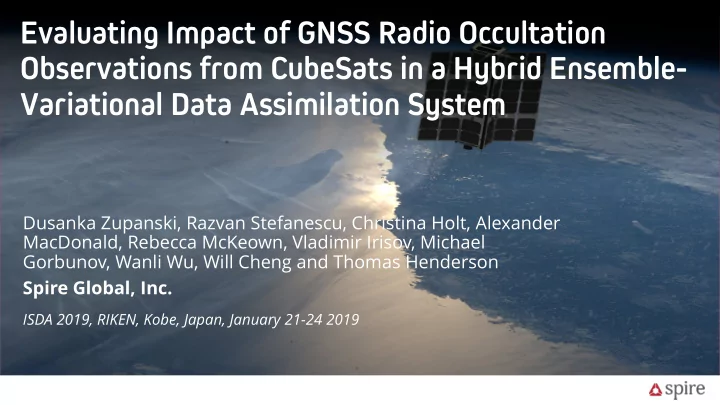

Evaluating Impact of GNSS Radio Occultation Observations from CubeSats in a Hybrid Ensemble- Variational Data Assimilation System Dusanka Zupanski, Razvan Stefanescu, Christina Holt, Alexander MacDonald, Rebecca McKeown, Vladimir Irisov, Michael Gorbunov, Wanli Wu, Will Cheng and Thomas Henderson Spire Global, Inc. ISDA 2019, RIKEN, Kobe, Japan, January 21-24 2019
OUTLINE • Spire 3U CubeSats Constellation • Data Assimilation System Design • Experimental Setup • Preliminary Results • Summary and Future Work 2
SPIRE CONSTELLATION ● 400-650 km orbits Snapshot of Spire satellites on January 10, ● Sun synchronous or 51.6 deg inc (ISS) orbits 2019. Pink areas cover the Earth surface where there is a direct line of sight to at ● Some new launches at ~85 deg inc least one Spire satellite. ● 28 Spire ground stations (one of the largest commercial GS networks) 3
SPIRE 3U CUBESAT: LEMUR2 v3.4 ● Orbiting satellites (v2.8, v3.0-3): 1 RO antenna, 2-panel solar arrays ● Ready for launch (v3.4): 2 RO antennas (2x collections), 3-panel solar arrays (increased duty cycle) 4
DATA ASSIMILATION SYSTEM DESIGN • Hybrid Ensemble-Variational DA method Ø EnKF-4DEnVar system Ø GSI and EnKF components developed and supported by NOAA and DTC Ø 20 ensemble members • Model for Prediction Across Scales (MPAS) Ø Model developed and supported by NCAR and LANL Ø 30 km Ø 655362 horizontal icosahedral grid cells Ø 55 layers Ø Top at 30 km Ø Standard “mesoscale_reference” physical package • Spire RO observation operator Ø 1D operator based on Abel transformation • DA on Gaussian lat/lon grid (not a native model grid) Ø Analysis increments interpolated from lat/lon to ICOS grid 5
EXPERIMENTAL SETUP • Control: Assimilation of NOAA observations only Ø NOAA/NCEP conventional and satellite BUFR data files Ø Non-Spire GPS RO bending angles (COSMIC 1, MetOpA, MetOpB, TerraSAR-X, Tandem-X) Ø No NOAA restricted data (e.g. aircraft, mesonet data) • Experiment: Assimilation of NOAA observations (control) + Spire RO Ø Spire RO bending angle profiles are assimilated Ø Typically around 200 Spire RO profiles were available per DA cycle Ø Spire RO observation errors as in NOAA/NCEP system (for COSMIC 1 data) • DA assimilation experiment covered 11 days Ø October 20 – 30, 2018 Ø 6h DA cycles • Impact of short-term forecast (up to 48h) evaluated Ø GFS analysis used as “truth” 6
RESULTS – ANALYSIS AND 48H FORECAST DIFFERENCES AT 100 HPA Black dots indicate Spire RO profiles (121 total) assimilated in DA cycle 2018102300 Analysis, 48h Forecast, Differences grow with time 7
FORECAST VERIFICATION – SPIRE RO IMPACT ON TEMPERATURE AND GEOPOTENTIAL HEIGHT (24 H FORECASTS, UPPER LEVELS) Blue – Spire RO GFS analysis = “Truth” Orange – No Spire RO Forecast RMSE Verification time Relatively small, but consistent positive impact of Spire RO data! 8
FORECAST VERIFICATION – SPIRE RO IMPACT ON TEMPERATURE AND GEOPOTENTIAL HEIGHT (48 H FORECASTS, UPPER LEVELS) Blue – Spire RO GFS analysis = “Truth” Orange – No Spire RO Forecast RMSE Verification time Other variables and levels below 500 hPa had negligible impact (not shown) 9
SUMMARY • DA experiment was performed over 11-day period in October 2018 • Around 200 Spire RO bending angle observations were assimilated per DA cycle • Preliminary results indicated positive impact on short term forecasts (up to 48h) Ø Temperature and geopotential height at upper atmospheric levels Ø Results in agreement with expected results from other studies (NOAA, ECMWF, UK MetOffice) • Neutral impact below 500 hPa and for other variables Ø Wind, humidity, cloud species 10
FUTURE WORK • Explore bias fee RO data advantage (e.g., Cucurull et al., 2014). Ø Run bias correction experiments for MW and IR satellite data • Evaluate impact of more Spire RO Profiles Ø Ramping up to 4000-5000 Spire RO profiles per day expected in early 2019 • Relax assumption that Spire RO errors = COSMIC 1 errors Ø Diagnose Spire RO observation errors (e.g., Desroziers et al., 2005) • Evaluate impact of 2D RO operators (e.g., ECMWF 2D operator) • Work with our partners to further evaluate impact of Spire RO data Ø Contracts already in place for NASA, NOAA, ESA, US Air Force, UK Met Office • Researchers with existing NASA proposals can get Spire RO observations for free Ø More information at https://www.nasa.gov/press-release/nasa-evaluates-commercial- small-sat-earth-data-for-science) 11
For any questions, please contact: Dusanka Zupanski Dusanka.Zupanski@Spire.com 1825 33 rd Street, Boulder, CO 80301 USA 1050 Walnut, Suite 402, Boulder, CO 80302 USA 12
Recommend
More recommend